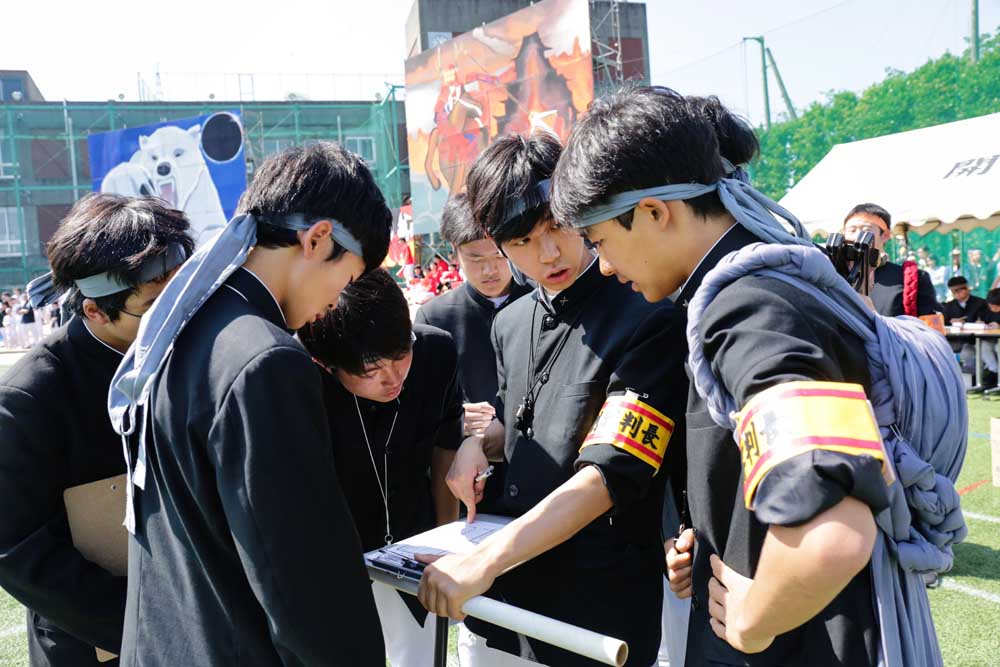Japan’s wildest game is organized chaos
Published 11:01 pm Wednesday, August 22, 2018

- Sotaro Yokoi, center, confers with other judges at a botaoshi tournament, in which students try to topple an opposing’s team pole while protecting their own, at the Kaisei Gakuen school’s annual festival in Tokyo, May 14, 2018. Though many Japanese schools have concluded that the chaotic, century-old game is too hazardous, here it lives on as a cherished rite of passage. (Ko Sasaki/The New York Times)
TOKYO — On a cloudless spring afternoon, thousands of parents, teachers and alumni watched as a pack of young students charged across a field, screaming and snarling, and then crashed into a wall of students defending an 11.8-foot wooden pole. The attackers clawed, shoved and jumped over the opposition. Heads butted. Elbows were thrown. The wall buckled, then stood firm. Like a mast on a sailboat in rough seas, the pole dipped, then rose again.
This was not trench warfare, it was botaoshi, a century-old game that combines elements of American football, rugby, sumo and martial arts. The game has gotten so dangerous that many Japanese schools have abandoned it, but it lives on at Kaisei Gakuen, where it is the centerpiece of the school’s annual sports festival.
Little known in America, botaoshi, or “topple the pole,” remains a rite of passage at Kaisei, which opened in 1871 and is one of Japan’s most prestigious secondary schools. Teachers say the game promotes teamwork, toughness and sportsmanship. Students eagerly await their chance to compete in the tournament in their junior and senior years. (Underclassmen play more rudimentary games.) Alumni can recount details of games played decades ago.
“Since my first year in junior high school, I was watching my senpai,” Makoto Nakagawa, a recent Kaisei graduate, said of his upperclassmen. “The image of botaoshi was at the center of everything. It’s a tradition.”
Twice the Mayhem
To the uninitiated, botaoshi looks like mass chaos. At one end of a field, two dozen attackers try to pull down a pole while two dozen defenders try to keep it upright.
At the other end of the field, the mirror image unfolds, except the attackers are on the same team as the defenders 50 or so feet away, and the defenders are teammates with the attackers.
The first team to lower the tip of the pole to below 55 inches from the ground within 90 seconds wins. If neither team succeeds, they start over. If the second game ends in a draw, the tie is broken with a lottery.
At Kaisei, the attackers and defenders wear colorful headbands and chant “Fight to the finish!” and “Win at all costs!”
The players wear little protective gear besides soft helmets, kneepads and athletic cups. Sprains, cuts and bloody noses are common and normal. Every so often, students may fracture leg bones, vertebrae and cheekbones or suffer a concussion.
After practice, students pile into the nurse’s office.
The number of injuries in botaoshi has risen in recent years. According to school records, the number of injuries jumped 52 percent from 2005 to 2016, the most recent year for which records were available.
The increase can partly be attributed to better reporting, said Tetsuo Shimizu, a longtime math teacher at the school and a spokesman for the festival, but also to a gap between athletically inclined students and an increasing number drawn to other pursuits but who also participate in botaoshi.
“Students who are in sports clubs and students in art and literature clubs who never do sports are all mixed together,” said Satoshi Matsumoto, a Kaisei graduate and doctor who volunteered at the sports festival. “It is impressive that there are no serious accidents.”
‘It Was Just a Head-On Fight’
Botaoshi has been a part of Kaisei’s sports festival since 1929, although the game was created years before.
Minoru Matsunami, a sports historian at Tokai University, said botaoshi might be a combination of several recreational games popular in the 1890s, such as sao nobori (pole climbing), hata tori (capture the flag) and tsuna nobori hata tori (climbing a rope and grabbing a piece of cloth).
He said another theory is that botaoshi was modeled after a version of capture the flag, or taisho tori, except a flag was on top of a pole. The game was played by students in Kagoshima in southern Japan who may have brought it to the naval academy in Hiroshima prefecture. It may be the origin of the botaoshi still played at the National Defense Academy.
Conditions were rougher years ago. At Kaisei, games would typically last about five minutes, and ties would result in endless replays, so tournaments stretched into the night. Students wore little protective gear. Rules were printed on a few pages.
“We didn’t have any meticulous game plan like in American football,” said Akito Hattori, who graduated from Kaisei in 1977 and broke his clavicle as a defender playing botaoshi. “It was more savage and loose.”
Shin Sone, his best friend from that era who was an attacker in botaoshi, was blunter. “It was just a head-on fight,” he said.
Making the Game Safer
The question is why, in the age of helicopter parents, a game that causes so much mayhem endures at Kaisei while other schools have abandoned it.
American boys play football, hockey and other contact sports. But they wear protective gear, and the danger is tolerated in part because the best athletes can earn college scholarships.
Botaoshi, by contrast, is played only at the sports festival, or undokai, which is woven into the fabric of the school. Students spend months practicing and planning for it. Alumni said fighting shirtless in close quarters broke down barriers and built bonds, and spoke of Kaisei Kenji, the toughness of Kaisei students.
Some students said they still feared being hurt. But they were confident the game would endure at the school.
“Every year, if a very serious accident happens, we come up with some countermeasures and revise the rules,” said Ryuta Ishikawa, the captain of the team that won this year’s tournament.
While concerned, many parents accept the game.
“It is dangerous, but I trust them because their rules are very detailed and reviewed each year,” said Yuichi Higuchi, who took time off work to see his son, a senior, take the field. “I want him to come back without any injuries.”
Months of Strategy for 90 Seconds of Battle
Unlike many Japanese schools, students at Kaisei are given a lot of autonomy to run the sports festival. For months, they plan all the logistics of the event, refine the game rules and devise strategies to win. The festival’s rule book, written in a tiny Japanese font, is 124 pages.
“The teachers trust us and let us do what we want freely,” said Sotaro Yokoi, a junior and a chief umpire. But, he added, the teachers will step in if someone gets seriously hurt.
Students are divided into eight teams, each named for a color. The winner must capture three matches in a row.
The excitement this year was palpable. “Old boys” stood near the grandstands for the teams they once played on. Parents screamed encouragement to their sons. Underclassmen, led by cheerleaders, chanted fight songs.
The screams got louder when attackers started pulling down a pole and defenders rushed underneath and used their shoulders to keep it aloft. Gasps could be heard each time an attacker launched himself over the defenders and reached the pole. More cheers rose when defenders pulled the attackers away.
In the final match, time expired before the yellow and purple teams could topple the pole. Judges measured the distance of the poles from the ground and ruled that the yellow team had won. The championship theirs, the winners threw their helmets in the air and ran a victory lap in jubilation.






